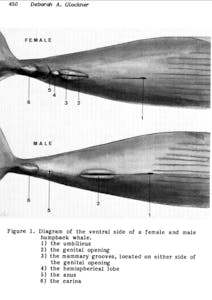Male? Female? How Can You Tell?
Aloha,

Our Thursday Wake Up with the Whales Cruise was one of those trips that just kept getting better and better. It was pretty windy and bumpy when we first headed out of the bay, but we were seeing splashes from Humpbacks on the surface out near the horizon. Of course with all that wind, traveling out that far wasn’t really an option. But as it turned out, we didn’t need to, as we ended up seeing about a dozen different Humpbacks all within 1/2 mile of the shoreline. As we cruised up the shoreline, we kept getting surprised by Humpbacks (who we hadn’t seen and didn’t know were in our vicinity) surfacing close to us. We ended up having multiple close encounters with curious whales, and we even got to see a breach from one of them in our hundred yard range. As it happened, we were all looking in the correct direction (which is really pretty rare)…and this whale breached so high, that at top of his breach, only the tips of his flukes were touching the surface of the ocean.
The wind was blowing in Kawaihae during our Mid-Morning Whale Watch Cruise, but a pod of Spinner Dolphins found us and escorted us as we cruised up the coastline. About as far north as we ever go, we found a competitive pod of 3 Humpbacks and we spent some time watching them interact with each other. We saw a couple other blows further out to sea, but that wind was just too strong for us to investigate. Then, on the way back to the harbor, our Spinners found us again, and decided we worth playing with for awhile a second time. When we came in from that cruise, we boarded a group of 4th graders from The Learning Center, their teachers, and some lucky parents for a dedicated Educational Whale Watch Cruise. As usual, the keiki bring us luck, and we hardly had to leave the harbor before we found a pod of 2 Humpbacks. The kids enjoyed seeing the whales but they might have enjoyed playing Hide & Seek on the boat a bit more!
Have a fun weekend. I’ll post our next report on Monday.
Claire
